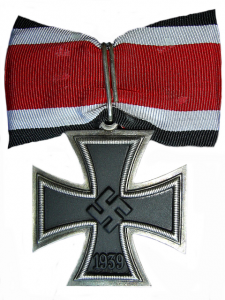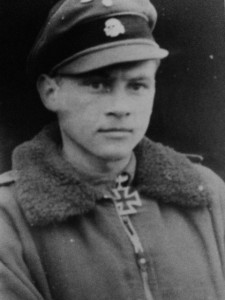Awarded to Michael Wittmann on 14th January 1944 as SS-Untersturmführer and Tiger I/platoon Commander, 13. (schwere) Kompanie, SS Panzer Regiment 1, 1. SS Panzer Division Leibstandarte SS Adolf Hitler, Eastern Front, for exceptional bravery in the face of the enemy and for the destruction of 88 enemy tanks.
Slightly larger in size but similar in design to the traditional Iron Cross, the Knight’s Cross was to be worn at the throat from a 45mm-wide (or in some cases 46mm) red, white and black ribbon made from high-quality silk, although individual recipients sometimes used a different or more durable ribbon to keep the cross in place (the standard 30mm Iron Cross 2nd Class ribbon, for example).
All Knight’s Cross pieces were hand-made to a high specification – unlike the Iron Cross First and Second Class, both of which were machine-produced – and was a two-piece construction of a blackened iron centre held within a .800 or .935 grade silver frame, although a few examples were manufactured with silver-plated frames.
 |
 |
The obverse of the award was centred with a rotating Swastika and the year of the award’s institution, “1939”, at the base of the lower arm, and the reverse featured the date “1813”, the original year of the inception of the Iron Cross series of awards. The Cross was awarded with a specially-tailored small black case, although when presented it was usually hung around the neck of the recipient.
